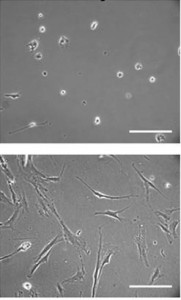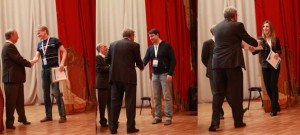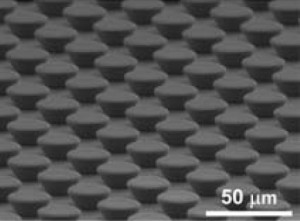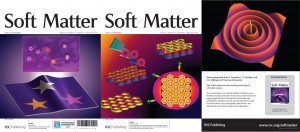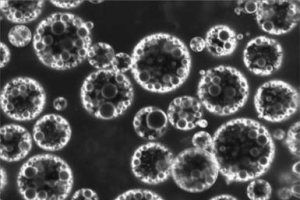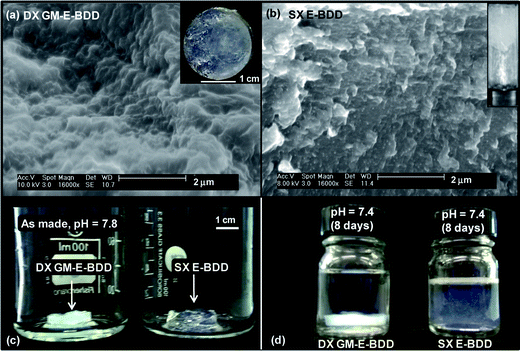 Soft Matter article on a gel that can fix back aches has been reported in the Daily Mail and the Telegraph. The work by Dr Brian Saunders and Professor Tony Freemont at the University of Manchester, involves the injection of a liquid containing microgel particles into the spine where the sponge-like particles expand to form a strong, load-bearing material.
Soft Matter article on a gel that can fix back aches has been reported in the Daily Mail and the Telegraph. The work by Dr Brian Saunders and Professor Tony Freemont at the University of Manchester, involves the injection of a liquid containing microgel particles into the spine where the sponge-like particles expand to form a strong, load-bearing material.
Archive for the ‘News’ Category
Soft Matter makes the news!
Top ten 2010 continued…
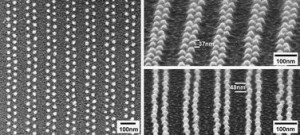 This is the second in a series of blogs looking at the most cited articles in Soft Matter. The first part can be found here. The countdown continues with the top five in the top ten 2010.
This is the second in a series of blogs looking at the most cited articles in Soft Matter. The first part can be found here. The countdown continues with the top five in the top ten 2010.
At number 5… In fifth place, with 14 citations, is ‘Block copolymer multiple patterning integrated with conventional ArF lithography‘. As technology continues to miniaturise, patterning on the nanometre scale (sub 30 nm) is no longer just desirable, but a requirement for semiconductor devices and chips. In this article, Park et al. combine photolithography with the self-assembly of block copolymers to create patterns down to 20 nm in size.
Initially, the photoresist was patterned using the industry standard 193 nm ArF lithography to create an asymmetric pattern. An underlying polymer brush layer was then oxidised and the photoresist washed away. The result was a chemical asymmetric pattern of alternating neutral and polar stripes. The block copolymer was spun onto this and self-assembled to create arrays of standing cylinders aligned with the underlying pattern. Examples can be seen in the image above. These block copolymers were then used as templates to create arrays of nanodots and nanopillars. This method provides a simple way to pattern on the sub 20 nm scale and avoids multiple photolithography steps or switching to shorter wave-length light sources.
The citing articles all look at patterning on the nanoscale. One article worth highlighting is that of Lee et al. published in Adv. Funct. Mater. This article reviews tailored and self-assembly of carbon nanotubes and graphene to form 3D patterns. Park’s block copolymer templates offer a way to direct the growth of nanotubes into well-ordered arrays. Graphene has also been used to chemically modify surface energy. Deposition of block copolymers onto these graphene films results in highly aligned perpendicular lamellae, which can then be used for patterning.
At number 4… Next up, with 15 citations, is ‘Spatially controlled hydrogel mechanics to modulate stem cell interactions‘. This is the third (but not final) appearance of hydrogels in the top ten 2010. The focus of the paper is on how hydrogel properties affect the spreading and proliferation of human mesenchymal stem cells. Understanding this behaviour has importance and relevance in tissue engineering and cellular behaviour in disease states.
The morphology and proliferation of the stem cells were seen to be highly dependent on the underlying hydrogel. Increased spreading and growth was seen for stiffer hydrogels. Wang et al. have gone on to show that stiffer surfaces also result in more organised cytoskeletons, more stable focal adhesion and faster migration of the stem cells. In addition, gene expression was seen to differ for cells cultured on soft and hard hydrogels. On the softer hydrogels, neuron specific proteins were expressed by the cells, while on stiffer hydrogels there were not. Instead the cells expressed myogenic proteins. Very recently, Huang et al. proposed a mechno chemical coupling model to explain the dependence of spreading and adhesion on substrate stiffness.
At number 3… In 3rd place is ‘Nematic phases of bent core mesogens‘ with 16 citations. This paper by Keith et al., looks at the chain-length and temperature dependence of the phase behaviour of bent core mesogens. These mesogens, derived from 4-cyanoresorcinol with terminal alkyl chins, display broad metastable nematic phase ranges at ambient temperatures and do not have smectic low temperature phases. The authors suggest that mixtures of these compounds may potentially give rise to bent-core materials with stable nematic phases at room temperature.
At number 2… In second place is ‘In pursuit of propulsion at the nanoscale‘ by Stephen Ebbens and Jonathon Howse with 20 citations. Both authors are both currently at the University of Sheffield, UK. This review article looks at the developments in self-propelling nano and micro-scale swimming devices, with emphasis on swimming transporters. Ideally these swimmers should operate independently, without an external stimulus. Ebbens and Howse focus on bi-metallic nano-rod swimmers, which have been demonstrated to transport cargo. This was also discussed in a mini-review by Pumera.
Tierno et al. have shown that paramagnetic catalytic microellipsoids can be guided using external magnetic fields. Their particles align along the field and are seen to travel perpendicularly to the field in an almost straight trajectory. For spherical particles this is not the case. Sanchez et al. have developed autonomous hybrid biocatalytic microengines. These engines use enzymes as their catalysts and are able to achieve speeds of 10 body lengths per second. In a second paper, Sanchez et al. demonstrated the transportation of cells using microbots. However, while the microbots were self propelled, loading transporting and delivery of the cells was externally controlled. I should mention that the two papers by Sanchez discuss very different swimmers. It is clear that this is currently a very hot area or research, due in part to their wide ranging potential medical applications.
Number 1… And finally, at the top of the top ten 2010 is ‘Responsive reversible hydrogels from associative “smart” molecules‘, published online in February 2010. The review article by Constantinos Tsitsilianis looks at the reversible hydrogels through self-assembly and association mechanisms.
Soft Matter poster prize winners at the 7th Annual European Rheology Conference
Congratulations to Carolina Vannozzi at the University of California, Santa Barbara, USA, for winning the Soft Matter poster prize at 7th Annual European Rheology Conference in Suzdal, Russia. Carolina Vannozzi’s poster was on “An analytic expression for the disjoining pressure between particle-stabilized fluid-fluid interfaces and composite materials”.
The two Soft Matter runners up were Valery Karbushev at A. V. Topchiev Institute of Petrochemical Synthesis, RAS (TIPS RAS), Moscow, Russia, with his poster “Physical-mechanical and rheological properties of composites based on thermoplastic and nanodiamonds” and Sergey Litvinov at Technical University Munich, Germany with “Smoothed dissipative particle dynamics model for polymer solutions“.
From left to right are Sergey Litvinov, Valery Karbushev and Carolina Vannozzi. Congratulations to all three winners.
Top ten 2010
Since its birth in 2005, Soft Matter has quickly grown to be one of top (if not the top) journals in its field. The current impact factor of the journal is 4.87. In this and the next few blogs, I thought it would be interesting to explore the themes and articles being published in Soft Matter and their impact on the soft matter field. Obviously I can’t, nor would you want me to, discuss every article published in Soft Matter, so I will limit the discussion to the most cited articles (as determined by ISI Web of Knowledge). What are the hot topics? Who is writing these highly cited articles and who is citing them? In this first blog of the series, I will start with the top ten of 2010 and later the top ten of all time (well, since 2005).
Top ten 2010 (numbers 10-6)
At number 10… In tenth place, with 10 citations since its online publication in Feb ’10, is ‘A robust superhydrophobic and superoleophobic surface with inverse trapezoidal microstructures on a large transparent flexible substrate‘. In the article the authors Maesoon Im et al., from KAIST South Korea, demonstrate a large size flexible transparent PDMS microstructured surface, which is both oil and water repellent. Im et al. structured the surface of the PDMS to create an array of inverse-trapezoidal microstructures (see image).
Of the articles citing this work, three build on it directly. The authors look at the use of these structures for combined electrical insulation and water repellence (doi:10.1021/la101339t) and also their self-cleaning properties for potential solar cell applications (doi:10.1039/c0jm02463e). One important criterion for useable superhydrophobic surfaces is their durability. This was not discussed by Im et al. However, Su et al. have shown that similar superhydrophobic polyurethane elastomeric surfaces have high abrasion resistance, making them technologically very interesting.
This isn’t the first blog that I have written looking at superhydrophobic surfaces and it is likely not the last. Anything with the potential to make our lives easier (via self-cleaning), reduce energy consumption (via friction reduction) and enhance energy capture (by remaining dust free) is always going to be in the spotlight.
At number 9… In 9th place, also with 10 citations, is ‘Insights into the cybotactic nematic phase of bent core molecules‘. The article, written by Francescangeli and Samulski, was published online in April 2010. For those not in the liquid crystal field the term cybotactic here describes an assembly of molecules in a nematic mesophase, which are arranged in a short-range smectic-like array.
At number 8… With 11 citations, ‘Why are double network hydrogels so tough?’ makes it to number 8 in the top ten 2010. This review article by Jian Ping Gong, Hokkaido University Japan, provides an interesting overview of double network hydrogel research with particular emphasis on understanding their mechanical properties.
Hydrogels appear four times in the top ten 2010. One of the reasons for this is perhaps their suitability as artificial soft tissues, due to their high water content and high mechanical strength and toughness. From the citations to this article it can clearly be seen that there is a strong focus on enhancing the strength, durability and bonding of hyrodgels in aqueous environments. Also important for these biological applications, is that the hydrogel is biocompatible. This was highlighted in one of Gong’s most recent citations, where Bai et al. fabricated high strength fatigue resistant hydrogels with low cytotoxicity and antifouling properties. This hydrogel is not itself biodegradable. Bai et al. claim however, that their method could be easily adapted to form a biodegradable, biocompatible high-strength hydrogel with applications for tissue engineering scaffolds.
At number 7…Since its publication in March 2010, ‘Relationship between the molecular structure, gelation behaviour and gel properties of Fmoc-dipeptides‘ has received 12 citations, putting it at number 7. The second appearance for hydrogels, the focus of this paper is on how the chemical structure of the gelator (in this cast Fmoc-dipeptides) relates to the properties of the gel formed. The number of the amino acids in the dipeptide was varied allowing the hydrophobicity of the molecule to be tuned. Depending on the hydrophobicity different types of gel were seen to form.
Of the 12 citations for this article, all looked at various aspects of dipeptide gelation. In contrast to the double network hydrogels where strength and durability were key, for this class gel formation of the gel structure is reversible. The structure in the gel arises from the entanglement of the fibres via hydrogen bonding or π-π stacking, rather than cross-linking in the conventional sense (covalent or ionic bonding). This makes them attractive for drug release and wound treatment.
At number 6… And finally (for this blog), in 6th place is ‘Dendrons/dendrimers: quantized nano-element like building blocks for soft-soft and soft-hard nano-compound synthesis’. This tutorial review has received 13 citations since its online publication in December 2009 (not strictly 2010, but since it appears in the 2010 print edition it counts).
Tomalia defines dendrimers as “well defined collections of atoms that can be viewed as core-shell type atom mimics”. The focus of the review is to show that dendrons/dendrimers are emerging as a platform for synthetic nano-chemistry. This is reflected in the citations, which include papers on the use of dendrons/dendrimers for gene delivery, as biocompatible drug delivery vehicles, in blue LEDs and as self-assembling building blocks.
Soft Matter Communication highlighted by ACS Noteworthy Chemistry
Self-folding all-polymer thermoresponsive microcapsules: Partially biodegradable thermoresponsive self-folding capsules capable of controlled capture and release of cells have been created by a team based in Germany. Georgi Stoychev, Nikolay Puretskiy and Leonid Ionov demonstrated the principle using star-like patterned polycaprolactone-poly(N-isopropylacrylamide) bilayers, which reversibly encapsulate/release yeast cells in response to a temperature signal. (Soft Matter, 2011, 7, 3277-3279.)
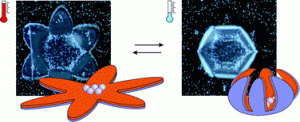
Top Ten most-read Soft Matter articles in March
The latest top ten most downloaded Soft Matter articles
See the most-read papers of March 2011 here:
DOI: 10.1039/C1SM90014E
DOI: 10.1039/C0SM01072C
DOI: 10.1039/C1SM05109A
DOI: 10.1039/C0SM01559H
DOI: 10.1039/C0SM01385D
DOI: 10.1039/C0SM01289K
DOI: 10.1039/C0SM00999G
DOI: 10.1039/C1SM05032J
DOI: 10.1039/C0SM01539C
DOI: 10.1039/C0SM00142B
Locomotion in fluids
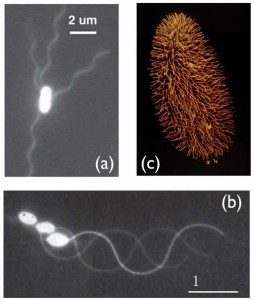
Various low Reynolds number swimmers. (a) E coili bacterium. (b) Swimming spermatozoon of Ciona intestinalis. (c) Paramecium cell.
This month’s fluid dynamics symposium, run by the Max-Planck Institute for Dynamics and Self-Organisation was on the topic of locomotion in fluids. Talks were given by Anders Andersen from the Technical University of Denmark, on Copepod dynamics, Albert Bae from UC San Diego, on swimming amoebae and Eric Stellamanns from the Max-Planck Institute for Dynamics and Self-Organisation, on Trypanosome motility.
Copepod hydrodynamics
Copepods are a group of small crustaceans and zooplankton found in both salt and fresh water environments. In terms of other plankton Copepods are fairly large, ranging in size from a few hundred microns to a few millimetres. In order to catch prey and escape from predators, the Copepods have small sensory hairs along their antenna and tails. These hairs or setae, detect small disturbances in the surrounding environment. If the disturbance is small (only picked up by few hairs) then the Copepod knows prey is nearby and can attack. If the disturbance is large (picked up by many hairs) then the Copepod knows to get ready to flee a potential predator.
In order to capture prey, the Copepods use ambush feeding. Most of the time the Copepod is motionless in the water waiting for prey to swim by. When one does, the Copepod springs into motion capturing the prey. The whole process of detection to capture takes only a few milliseconds, with the Copepod attacking at speeds of ~100 mm/s. On Anderson’s website a series of images can be found showing the attack process.
Apart from the speed and motion during attack, the main point of interest is that the prey remains stationary during the whole process, despite the Copepod moving substantially. This is of course necessary for a successful ambush; if the prey notices the Copepod moving it will potentially be able to escape. Simulations show that only a very thin viscous boundary layer develops around the attacking Copepod due to its high Reynolds number ~100, minimising the flow around the prey and preventing detection. The results were published in PNAS.
Also discussed in the talk were the kinematics of escape jumps in the Copepods. Copepods of all sizes use a cycle of power strokes and passive coasting to move from one place to another. Each cycle lasts 10-20 ms with the ratio of the stroke time to coasting time varying with the size of the Copepod. This mechanism results in a highly fluctuating escape velocity, with speeds of 120-450 mm/s being reached. The results can be found in the Journal of the Royal Society Interface, where a simple swimming model in used to accurately capture the kinematics of the motion.
Related papers in Soft Matter
Two recent interesting papers, published in Soft Matter, on the locomotion in fluids include: Life around the scallop theorem, Eric Lauga. This paper reviews methods of locomotion for swimmers at low Reynolds numbers. Hydrodynamic synchronisation at low Reynolds number, Ramin Golestanian et al. This paper reviews recent experimental and theoretical work on hydrodynamic synchronisation, such as that seen between bacterial flagella.
Soft Matter Issue 8, 2011 now online
Soft Matter issue 8 is now online. The outside front cover features “Photochromic materials with tunable color and mechanical flexibility” by Hyun-Kwan Yang, A. Evren Özçam, Kirill Efimenko and Jan Genzer (Soft Matter, 2011, 7, 3766-3774).
Highlighted on the inside front cover is the paper “Non-lithographic electrochemical patterning of polypyrrole arrays using single-layered colloidal templates on HOPG surface: effects of electrodeposition time and field-gradient” by Jin Young Park, Pampa Dutta and Rigoberto Advincula (Soft Matter, 2011, 7, 3775-3779)
The issue also includes 5 hot articles.
Emerging Area: Emerging area: biomaterials that mimic and exploit protein motion
William L. Murphy, Soft Matter, 2011, 7, 3679-3688
Communication: “Host–guest” interaction between cyclohexasilane and amphiphilic invertible macromolecules
Ananiy Kohut, Xuliang Dai, Danielle Pinnick, Douglas L. Schulz and Andriy Voronov, Soft Matter, 2011, 7, 3717-3720
Communication: Extraordinary long range order in self-healing non-close packed 2D arrays
Stefan B. Quint and Claudia Pacholski, Soft Matter, 2011, 7, 3735-3738
Communication: Universal soft matter template for photonic applications
Luciano De Sio, Sameh Ferjani, Giuseppe Strangi, Cesare Umeton and Roberto Bartolino, Soft Matter, 2011, 7, 3739-3743
Communication: Compartment size dependence of performance of polymerase chain reaction inside giant vesicles
Koh-ichiroh Shohda, Mieko Tamura, Yoshiyuki Kageyama, Kentaro Suzuki, Akira Suyama and Tadashi Sugawara, Soft Matter, 2011, 7, 3750-3753
The back cover showcases the work of S. Torquato, Chase E. Zachary and F. H. Stillinger. Duality relations for the classical ground states of soft-matter systems (Soft Matter, 2011, 7, 3780-3793). You can read the full issue here. I hope you enjoy it.
Top Ten most-read Soft Matter articles in February
The latest top ten most downloaded Soft Matter articles
See the most-read papers of February 2011 here:
DOI: 10.1039/C0SM01289K
DOI: 10.1039/B821272D
DOI: 10.1039/B712575P
DOI: 10.1039/C0SM01218A
DOI: 10.1039/C0SM00995D
DOI: 10.1039/C0SM01354D
DOI: 10.1039/C0SM00823K
DOI: 10.1039/C1SM05020F
DOI: 10.1039/C0SM00312C
DOI: 10.1039/C0SM01092H
Is food the way forward?
When someone asks you about food, the first things that come to mind are taste, smell, texture and appearance, but not perhaps science. However, over recent years a number of popular science and cookery books have started to appear, highlighting how physics and chemistry are important when we cook. Indeed a number of chefs have even started to exploit science, conducting unusual culinary experiments, to create gastronomical delights.
For the academic year 2010/2011, Harvard University introduced a new course for their first year undergraduates “Science and cooking – from haute cuisine to the science of soft matter”. Lectures, conducted by internationally renowned Chefs and faculty, used food and cooking to introduce undergraduates to fundamental principles in applied physics and engineering. Titles of the lectures included “Heat, temperature and chocolate”, “Emulsions: Concepts and stabilising oil and water” and “Olive oil and viscosity”. In an interview with Physicsworld, David Weitz discussed one lecture where Joan Roca (El Celler de Can Roca) made a ‘super cool’ dessert. Joan distilled water with eucalyptus to make a very pure water. This was placed into a refrigerator and cooled it to -5C. On removal from the fridge, the water was still liquid. The liquid was then poured onto a dessert Joan was making. As soon as it hit the dessert, it froze. The dessert was supercooled as well as being ‘super cool’. This led naturally to a discussion on supercooling.
For those in the Soft Matter community, science and food is not a new concept. Understanding soft matter from colloids, to gels, to foams and emulsions and how it behaves are important in the structure, stability, taste, flavour and nutrition of food. A quick search of ‘food’ brings up over two hundred articles in Soft Matter alone, including a food science web theme issue. A few recent articles are highlighted below.
Understandably, the course at Harvard was particularly popular with the students, as well as the chefs – who also learnt a lot about what goes on when they cook. What is perhaps particularly interesting, from David Weitz’s comments on the course, is that not only did students give a round of applause when a new culinary dish was created, but also when a new equation was introduced. While inviting international chefs to give lectures is not possible for every scientific institution, taking an everyday topic like food might perhaps be the pathway to inspire and promote science in those both young and old.
Designer colloids – towards healthy everyday foods?
In this review paper (doi:10.1039/c001018a), Norton and Norton discuss the design and construction of colloids to encapsulate and release micronutrients. The aim is to create foods with reduced calorific content that look, taste and smell good. To reduced calorific content, pure fat can be replaced by an emulsion with the water phase containing very few calories. If this is designed in the correct way, such that the water is not released until the food reaches the stomach, then the consumer will not detect the water at all. A number of examples are given as to how this may be achieved using colloids, gels, Pickering emulsions and duplex emulsions. By careful design of the system, it is possible to add water to levels regarded as impossible e.g. 50% or more in chocolate. However, it is important that the whole process from eating to digestion is considered in the design of the emulsions and colloids. For example, when stabilised by emulsifiers that are not broken down by the stomach, emulsions stay intact. This means that the body is unaware of the content of fat in the food and can result in the consumer over eating. A recent study (highlighted in Chemistry World) has shown that the size of the fat droplet produced by the emulsion in the stomach is also important. Larger droplets take longer to digest and leave us feeling fuller for longer (doi:10.1039/C0SM01227K).
Nanoemulsions can also be utilised to encapsulate and deliver lipophilic components such as vitamins and drugs (doi:10.1039/c0sm00549e). In this tutorial review, McClements provides an overview of the current status in nanoemulsion research, from fabrication and properties to their applications and suitability for food products. Nanoemulsions are an exciting development over conventional emulsions, as they can be incorporated into transparent foods and beverages without changing the appearance of the product and have improved stability. However, wide spread use will not happen until suitable food-grade materials are identified and safety concerns overcome.











